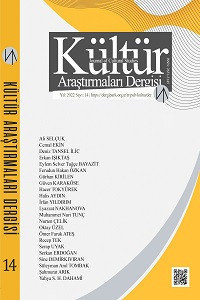İdeolojinin Çeviriye Etkisi: Arthur Miller'ın Death of a Salesman Oyununun İngilizceden Farsçaya Çevirisi
Çalışmanın temel amacı, ideolojinin bilinç ve bilinçsizlik yönleri ile bunların çeviri üzerindeki etkilerini ortaya çıkarmaktır. Araştırmacılar, yukarıda belirtilen öğeleri uygulamak için Arthur Miller'ın Death of a Salesman (1949) oyununu ve Ali Asqar Bahram Beygi'nin (1984) çevirisini mercek altına almışlardır. Ayrıca bu makale, ideolojinin bilinç düzeyinde duyusal deneyimi, pratik, yansıtıcı ve dönüşlü yönlerini analiz etmek için bir çaba sarf etmektedir. Bu çalışma, İngilizce-Farsça paralel külliyatın derlem tabanlı, karşılaştırmalı, tanımlayıcı ve yargılayıcı olmayan bir analizidir. Elde edilen sonuç, kaynak metnin (ST) ve hedef metnin (TT) analizi için ideolojinin bu iki ana yönündeki farkındalığın, çevirmenlerin kaynak metin ile hedef metnin sosyal ve durumsal bağlamında en yakın denkliği seçmelerine yardımcı olduğunu kanıtlamıştır. Ayrıca istatistiksel sonuçlar, ideolojinin en sık görülen yönünün %81 ile bilinç düzeyinde olduğunu göstermektedir.
Anahtar Kelimeler:
ideoloji, metin, çevirmenler, Arthur Miller, Death of a Salesman
The Effect of Ideology on Translation: English Translation into Persian in Death of a Salesman Play by Arthur Miller
The main aims of the study are to work out the framework of consciousness and unconsciousness aspects of ideology and their effects on translation. For applying the aforementioned items, the researchers put Death of a Salesman (1949) play by Arthur Miller and its translation by Ali Asqar Bahram Beygi (1984) under scrutiny. Furthermore, the present paper makes an effort to analyze sensory experience, practical, reflective and reflexive aspects at the consciousness level of ideology. This study is a corpus-based, comparative, descriptive and non-judgmental analysis of the English-Persian parallel corpus. The obtained result proved the fact that awareness rising in these two major aspects of ideology for the analysis of the source text (ST) and the target text (TT) help translators to choose the closest equivalence in the social and situational context of the ST and the TT. Moreover, statistical results indicate that the most frequent aspect of ideology is at the consciousness level with 81%.
Keywords:
ideology, text, translators, Arthur Miller, Death of a Salesman,
___
- Bassnet, Susan (2002). Translation Studies. London and New York: Routledge.
- Hatim, Basil & Mason, Ian (1997, 2005). The Translator as Communicator. New York: Routledge.
- Hatim, Basil & Munday, Jeremy (2004). Translation: An Advanced Resource Book. London and New York: Routledge.
- House, Julian (2015). Translation Quality Assessment. London and New York: Routledge.
- López, A. M. Rojo & Caro, M. Ramos (2014). “The Impact of Translator`s Ideology on the Translation Process: A Reaction Time Experiment”. Minding Translation, 5(5): 247-271.
- Miller, Arthur (1363 [1984]). Marge Pilevar. Trans. Ali Asghar Bahram Beigi. Tehran: İntişarat-ı Razi.
- Miller, Arthur (1949). Death of a Salesman. New York: The Viking Press.
- Oxford Advanced Leaner’s Dictionary (2010). New York: Oxford University Press.
- Simpson, Paul (1993). Language, Ideology and Point of View. New York: Routledge.
- The Advanced Leaner’s Dictionary of Current English (1963). London: Oxford University Press.
- The New Webster Dictionary (1984). London: Oxford University Press.
- URL-1: “Ideology”. https://en.wikipedia.org/wiki/Ideology_%28philosophy %29. (Date of access: 2018, April 17).
- Webster's Third New International Dictionary (1993). Springfield, Massachusetts: Merriam-Webster Inc.
- ISSN: 2651-3145
- Yayın Aralığı: Yılda 4 Sayı
- Başlangıç: 2018
- Yayıncı: Mehmet Ali YOLCU
Sayıdaki Diğer Makaleler
Dehümanizasyonun Gölgesinde, Korporatizmin Hizmetinde bir Posthümanizm Vizyonu: RoboCop
Sodom ve Gomore Romanının Metinlerarası Dünyası
Kaşar: Ekolojik Bir Kent İmgesi Örneği
Elçin Efendiyev'in Ak Deve Romanında Yapı ve İzlek
Göçün Kültürü mü, Kültürün Göçü mü? Almanya’daki Türklere Dair Bazı Hikâyeler
Mohammadreza VALİZADEH, Ahmad Ezzati VAZİFEHKHAH
Editöre Mektup: Hac Yolunda Bir Karınca, Prof. Dr. Mehmet Genç
Uğursuz Şölen: Dede Korkut'tan J. R. R. Tolkien'e Ortak Bir Motif
